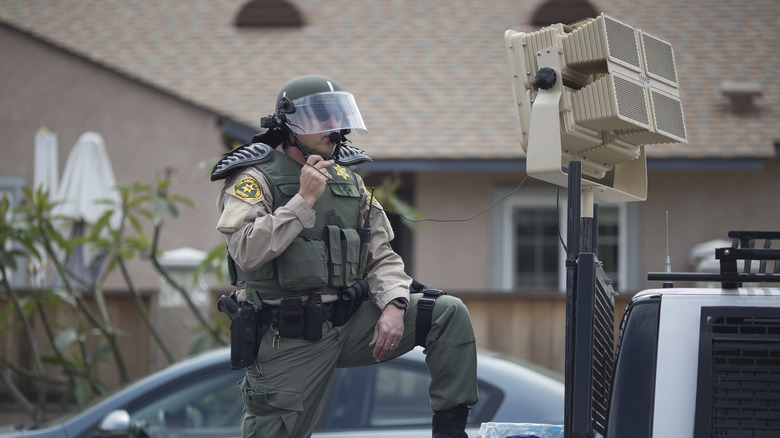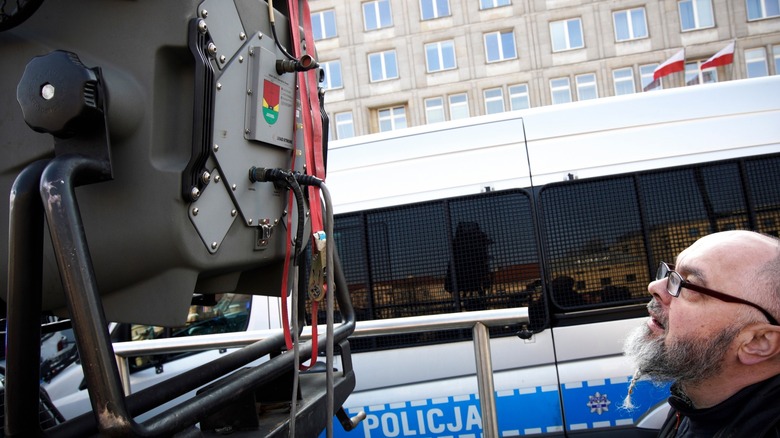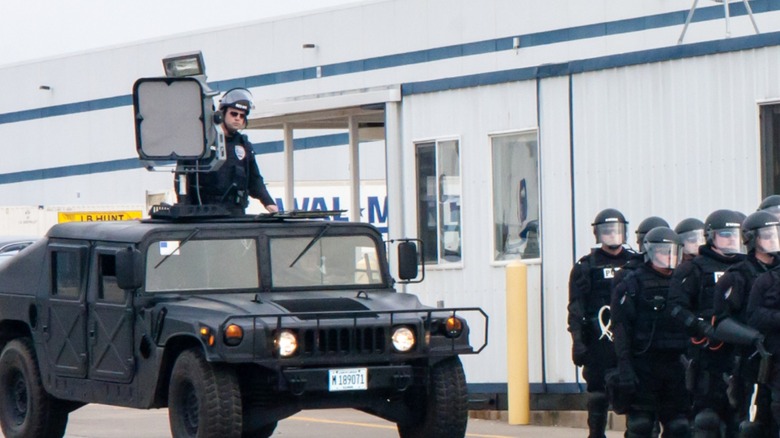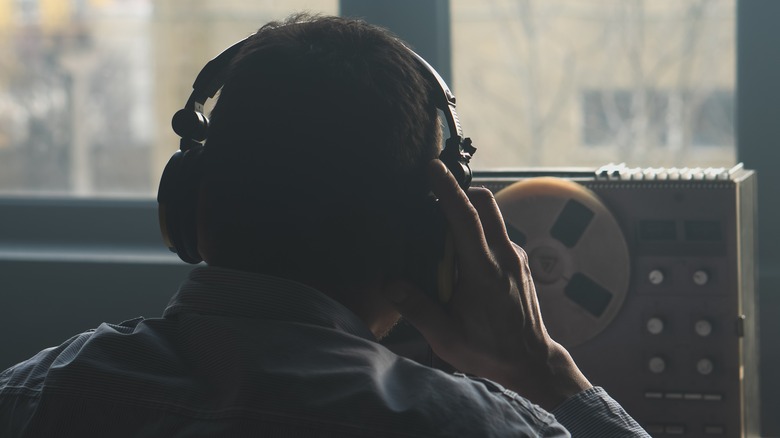Here's How The Military And Police Use Sound As A Weapon
Sonic weapons known as Long Range Acoustic Devices (LRAD), are used by law enforcement officials as a non-traditional method of crowd control and dispersal in multiple countries across the world. The United States is no exception.
LRADs were originally developed after an attack on the USS Cole in 2000 to allow ships to warn enemies and enforce border zones. These come in portable form factors that can be moved around, while the more powerful fixed type LRAD can be installed on vehicles, vessels, and even mounted on helicopters. Take, for example, the Lafayette Square protests of 2020, where federal law enforcement officials used the aforementioned sound-based weapon as a warning system before unleashing chemical irritants, batons, and shields on the crowd.
However, LRAD weapons are quite powerful on their own, and depending on the kit at hand and the magnitude of sound beams preferred by the operator, they can even end up causing permanent damage to the cochlear parts, induce dizziness, and more. Broadly, these sonic weapons fall under the category of Acoustic Hailing Devices (AHD) and are capable of sound levels far beyond what an average megaphone and loudspeaker can muster.
Unlike a regular Acoustic Hailing Device (AHD) deployed for communications, an LRAD sends a focused beam of sound at a specific target instead of transmitting sound in all directions. Think of them as a flashlight equivalent to lighthouses, but one that aims for the aural threshold of pain.
A brief history of acoustic weapons
The record of weaponizing sound waves goes all the way back to the 14th century BC. According to Biblical records, Prophet Joshua commanded his Israelite followers to blow ram horns as trumpets, which eventually brought down the Walls of Jericho. Archaeologists argue it was actually an earthquake that triggered the destruction. However, sound has also been deployed in the modern era as a means of psychological manipulation.
During the Vietnam War, the U.S. military blared haunting sounds as a form of psychological warfare to deprecate the morale of enemy forces, and so did the Indian Army in the contested territory of Kashmir. In 1989, the U.S. Army deployed what is popularly known as "music torture." To bring Panamanian military leader General Manuel Noriega out of hiding, the U.S. military blasted music by U2, Guns ' Roses, and Valen Halen using loudspeakers mounted on Humvees, eventually succeeding in their mission.
Cult leader David Koresh also played loud music to "harass" the FBI that surrounded his compound during a siege in 1993. The CIA is also said to have used 'sound disorientation techniques' as a form of torture on Guantanamo prisoners.
Genasys — formerly LRAD Corporation, which counts U.S. federal and the military among its clients — says LRAD systems are being used across 500 American cities and in 100 countries worldwide. The U.S. Army runs a $110 million AHD program, as part of which, it bought a fourth consignment of LRAD gear worth $14.8 million in 2019 from Genasys.
How sonic weapons work
An LRAD kit employs piezoelectric transducers. A piezoelectric material converts pressure into electrical signals, but in the reverse path, electricity applied changes the shape of the piezoelectric material rapidly. This rapidly creates waves that generate sound, combining their amplitude and producing nearly intolerable sound.
LRAD devices vary in their range and coverage. Genasys, which offers a wide range of LRAD hardware, says its product can cover anywhere between 30 to 360 degrees of the target area, and the sound emitted can be heard at a distance of up to 2,000 meters.
The devices look like a dish but can beam an excruciatingly loud siren-like painful noise. In one incident where the U.S. Defense Department employed an LRAD, it scared off sea bandits trying to attack a cruise ship using a "sound cannon." Scientists in China have even developed a handheld version.
Police use of LRAD
Law enforcement agencies across the United States have controversially deployed LRAD, but many regard it as excessive force. The New York Police Department used LRAD at a Black Lives Matter protest in Manhattan in 2014. A lawsuit was soon filed by some of the victims, who reported experiencing migraines even five years after exposure to the acoustic blast, damaged nerve, and even a bone pushed inward due to the sound pressure.
In 2018, the Phoenix City Council approved the purchase of two powerful LRAD devices but vowed that it wouldn't weaponize the controversial device. The model purchased by the Phoenix police peaks at 154 decibels, which is significantly above the harm levels outlined by the CDC. The machine in question is the LRAD-500X and happens to be "the U.S. Navy and U.S. Army's acoustic hailing device of choice for small vessels and vehicles."
In 2020, Genays announced that law enforcement officials in "Portland, OR, San Jose, CA, Colorado Springs, CO, Phoenix, AZ, Columbus, OH, Charleston, SC, Ft. Lauderdale, FL" have used LRAD systems to "communicate unlawful assembly and other orders to crowds after recent protests turned violent."
The Australian Federal Police, alongside law enforcement officials in Victoria, Queensland, South Australia, and Western Australia, have also purchased Genasys' LRAD gear. The first deployment happened at Pittsburgh's G20 protest in 2009. Israel's version is called "The Scream;" it has been used by the Israel Defense Forces and Israel Police to crush protests.
Health risks of LRAD
LRAD weapons primarily target the sensitive ear membrane, but their damage can run deeper. Unfortunately, there is not much peer-reviewed research into the entire spectrum of physical and psychological risks posed by sonic weapons, but witness and patient accounts offer enough information to ascertain that these tools are strikingly dangerous.
Even a second of exposure at 140dB can cause permanent hearing loss. Exposure to sounds this loud can also cause migranes and dizziness. Some report that after being exposed, loud sounds like sirens cause them to have similar symptoms months after exposure to LRADs.
— Marisa Ewing-Moody 🏳️🌈 (@sassy_composer) June 7, 2020
A faculty member from the John Jay College of Criminal Justice told the Orlando Sentinel that people within 15–20 meters range of an LRAD device can suffer hearing damage. "There are cases reported between 1990 and 2015 of hearing loss and prolonged ear pain or ringing," says a report by Physicians for Human Rights. "The effects are like a 'punch in the guts,' ranging from nausea to involuntary evacuation of the bowels," writes Professor of Computing, Ian McLoughlin, in The Conversation.
Concerns around LRAD
The use of sonic arsenal by law enforcement officials is a topic of hot debate, with activist bodies claiming that it is brute, dangerous, and should only be deployed in dire scenarios. But the definition of "dire" varies. Take, for example, the U.S., which has deployed it on its own civilians on multiple occasions and has also used these weapons in the invasion of Iraq.
From a health perspective, the biggest concern is that frequent and indiscriminate deployment of LRAD and similar weapons can turn temporary hearing issues into permanent ailments. Moreover, a dangerous and sophisticated tool with such damage potential should only be put into the hands of a trained expert with due knowledge of the tech behind it and the threat it poses to the human body.
Experts say utilization of this weapon should focus exclusively on de-escalation of violence, and even at that, the use of LRAD should be kept at a bare minimum, strictly proportional, and targeted. Restraint and considerate deployment are recurring themes in the debate so that injuries and loss of life can be minimized at all costs.
Another crucial consideration is that LRAD weapons should not endanger any non-involved person, as there have been incidents in the past where even the officials using long-range acoustic weapons suffered from the impact, and so did the people in the vicinity that were not even the target of these dangerous sonic machines.
The silent side of sound attacks
When one thinks of acoustic weapons, LRADs are the first name that comes to mind, especially owing to their capability of blasting a focused sound beam that can reach 160 decibels. To put that into context, the CDC says sounds above 100 decibels lead to hearing loss, pain, and injury. But as mentioned above, high-ranking government officials and federal employees have been targeted a silent class of acoustic weapons that fall under the infrasonic class.
Acoustic weapons are mostly perceived as a method of crowd dispersal, even in warfare, but reports say there's more to it. LRADs are the most popular form of sound-based weapons, but sonic weapons come in two forms. While LRADs are known to emit loud noise, there's another category called infrasound acoustic weapons, which don't emit loud noise.
They blast a frequency that human ears can't perceive but can be extremely disorienting and pain-inducing. According to a paper published in the Biomedical Journal of Science & Technical Research, infrasound acoustic weapons have been "demonstrated to affect recipients with symptoms including fear, sorrow, depression, anxiety, nausea, chest pressure, and hallucination." It further adds that infrasound waves, when weaponized, can also affect internal organs.
Clandestine use of sonic weapons
According to The New York Times, the U.S. government evacuated employees working at the consulate in China after they started exhibiting signs of a mysterious sound and pressure-related sickness which was allegedly due to "a form of aural harassment."
The "health issues caused by the sounds and sensations" were also accompanied by mild traumatic injury in some cases. "American diplomats at the consulate have complained of symptoms similar to those 'following concussion or minor traumatic brain injury,' and may have been targets of attacks involving strange sounds," says another report by NYT.
The mysterious illnesses that targeted US diplomats and intelligence officials in China was reportedly the work of infrasound weapons. Such incidents are not limited to China, however.
In 2016, the U.S. government also evacuated employees from Cuba, where around two dozen American citizens reported "headaches, nausea, hearing loss, cognitive issues, and other symptoms after saying they heard odd sounds." It was called Havana Syndrome. A New York Times report from 2018 notes that the U.S. expelled all Cuban diplomats from its soil after the aforementioned incident.
An intelligence official, who was a part of the CIA Director Bill Burns' team, also reportedly became a target of the Havana Syndrome in India back in 2021, according to CNN. Similar cases have also been reported in Colombia, Russia, and Uzbekistan. The CIA says the number of officials afflicted by the Havana Syndrome sits around 200, but the official investigations put the number at around 1,000.
A bowl of sonic mysteries and risks
The Havana Syndrome continues to be a mystery for warfare experts as well as intelligence officials. in 2022, an interim report by the U.S. intelligence agency attributed "most" cases of the Havana Syndrome to medical or environmental causes. Following a longer investigation, the CIA released another report in which the agency mentioned that "it is 'very unlikely' a foreign adversary" was behind the mysterious illnesses targeting U.S. intelligence officials and diplomats.
According to a BBC investigation, microwaves were the likely "attack" vector, which some of the targets described as "buzzing" and unpleasant "grinding metal" sound sensations in their ears. Multiple reports also mention nausea as the recurring aftermath of sonic attacks from LRAD kits. However, despite the CIA ruling out any foreign involvement and pointing fingers at non-adversarial factors, not everyone is convinced.
The Defense Department, in partnership with the Army and Air Force research labs, launched their own investigation into the mystery and have started testing acoustic that can replicate the effects, reports Politico.
Away from the world of police and intelligence, there are other ways bad actors can weaponize sound. For example, researchers have already demonstrated that an average speaker can be hacked to emit harmful sounds, causing hearing impairment and psychological harm. At the end of the day, the use of sound as a weapon and the scope of damage is vast, with little respite in sight.






